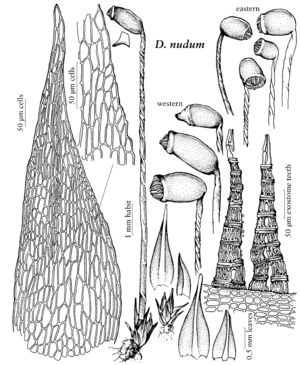Difference between revisions of "Discelium nudum"
Bryol. Univ. 1: 366. 1826,.
FNA>Volume Importer |
imported>Volume Importer |
||
| (5 intermediate revisions by 2 users not shown) | |||
| Line 6: | Line 6: | ||
|place=1: 366. 1826, | |place=1: 366. 1826, | ||
}} | }} | ||
| − | |basionyms={{Treatment/ID/ | + | |basionyms={{Treatment/ID/Basionym |
|name=Bryum nudum | |name=Bryum nudum | ||
|authority=Dickson | |authority=Dickson | ||
| + | |rank=species | ||
| + | |publication_title=Fasc. Pl. Crypt. Brit. | ||
| + | |publication_place=4: 7, plate 10, fig. 15. 1801 | ||
}} | }} | ||
|synonyms= | |synonyms= | ||
| Line 34: | Line 37: | ||
-->{{#Taxon: | -->{{#Taxon: | ||
name=Discelium nudum | name=Discelium nudum | ||
| − | |||
|authority=(Dickson) Bridel | |authority=(Dickson) Bridel | ||
|rank=species | |rank=species | ||
| Line 49: | Line 51: | ||
|publication year= | |publication year= | ||
|special status= | |special status= | ||
| − | |source xml=https:// | + | |source xml=https://bitbucket.org/aafc-mbb/fna-data-curation/src/2e0870ddd59836b60bcf96646a41e87ea5a5943a/coarse_grained_fna_xml/V27/V27_274.xml |
|genus=Discelium | |genus=Discelium | ||
|species=Discelium nudum | |species=Discelium nudum | ||
Latest revision as of 21:25, 5 November 2020
Plants gregarious to widely spaced, obvious only when sporophytes present on persistent protonema.
Phenology: Capsules mature spring.
Habitat: Moist silty to fine sandy banks of somewhat shaded sites
Elevation: low to moderate elevations (5-1500 m)
Distribution

Alta., B.C., N.W.T., N.S., Que., Calif., Ill., Mass., N.J., N.Y., Ohio, Pa., Wash., Europe, Asia.
Discussion
Discelium nudum is a very distinctive species: red-brown peristome on subspherical to elongate horizontal capsule arise on twisted seta from reduced brownish gametophyte and persistent green protonema making it unlike any other North American moss. On the Pacific coast in southwestern British Columbia and adjacent Washington, the sporophyte is often 4–5 times the size noted in the rest of its world range. The capsules are often elongate rather than subspheric and setae can exceed 3 cm, compared to less than 1 cm elsewhere in its range.
Selected References
None.
